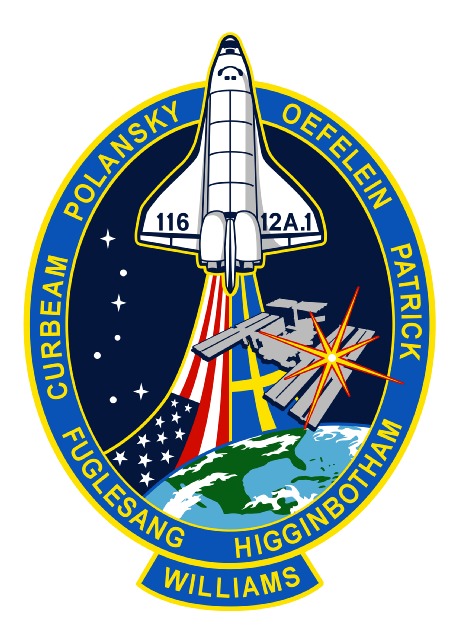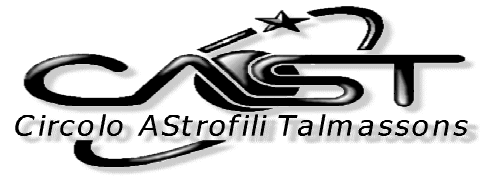
Missione STS-116: la sua preparazione (2005-2006)
di Lucio Furlanetto
Missione Space Transport System 116
Lancio (Launch): 9 Dicembre 2006 - ore 01:47 UT
Sito del lancio (Launch Site): Kennedy Space Center (Florida-USA)
Orbiter (Orbiter): Discovery
Sigla della missione (Mission Number): STS-116 (117° volo di uno space shuttle)
Durata della finestra di lancio (Launch Window): 10 minuti
Rampa di lancio (Launch Pad): 39B
Durata della missione (Mission Duration): 12 giorni (diventati 14)
Atterraggio (Landing): 21 Dicembre 2006 - ore 22:32 UT
Sito dell'atterraggio (Landing Site): Kennedy Space Center (Florida-USA)
Inclinazione/Altitudine dell'orbita (Inclination/Altitude): 51,6° (degrees) / 122 miglia nautiche (nautical miles)
Carico primario (Primary Payload): Ventesimo volo per la Stazione Spaziale Internazionale (Twentieth station flight) (12A.1),
P5 Truss, SPACEHAB.
Per maggiori informazioni leggete http://spaceflight.nasa.gov/gallery/images/shuttle/sts-116/html/sts116-s-001.html.
STS-116 TIMELINE OVERVIEW (Programma delle operazioni da fare durante la missione STS-116)
FLIGHT DAY 1:
• Launch • Payload Bay Door Opening • Spacehab Module Activation • Ku-Band Antenna Deployment • Shuttle Robot Arm Power Up • External
Tank Handheld Video, Umbilical Well Imagery and Wing Leading Edge Sensor Data Downlink
FLIGHT DAY 2:
• Shuttle Robot Arm Checkout • Shuttle Robot Arm Grapple of Orbiter Boom Sensor System (OBSS) • Inspection of Shuttle Thermal
Protection System and Wing Leading Edge Reinforced Carbon-Carbon (RCC) • OBSS Berthing • Spacesuit Checkout • Orbiter Docking
System Outer Ring Extension • Airlock Preparations • Rendezvous Tool Checkout
FLIGHT DAY 3:
• Rendezvous Operations • Terminal Initiation Engine Firing • Rendezvous Pitch Maneuver and ISS Digital Photography of Discovery •
Docking to the International Space Station • Hatch Opening and Welcoming by Expedition 14 Crew • Suni Williams joins Expedition 14
crew with Soyuz seatliner transfer; Thomas Reiter joins shuttle crew • Shuttle robot arm grapple of P5 spacer truss and handoff to
station robot arm • Curbeam and Fuglesang sleep in Quest Airlock for spacewalk pre-breathe campout protocol
FLIGHT DAY 4:
• Station robot arm installs P5 spacer truss installation on P4 truss attachment • Curbeam and Fuglesang EVA # 1 to connect P5 / P4
power cables, release launch restraints and to change out TV camera on S1 truss • Mobile Transporter moves from Worksite 7 to Worksite 3
FLIGHT DAY 5:
• P6 truss port array is retracted to enable Solar Alpha Rotary Joint activation and rotation on P4 truss • P4 Solar Alpha Rotary
Joint activation and autotracking of the sun • Port side loop of External Active Thermal Control System is filled with ammonia
• Curbeam and Fuglesang sleep in Quest Airlock for spacewalk pre-breathe campout protocol
FLIGHT DAY 6:
• ISS power down of electrical channels 2 and 3 • Curbeam and Fuglesang EVA # 2 to reconfigure electrical channels 2 and 3,
relocate Crew Equipment Translation Aid (CETA) carts 1 and 2 • ISS Treadmill Vibration Isolation System gyroscope replacement
and maintenance • Port side loop of the External Active Thermal Control System is activated to allow ammonia to flow • ISS power
up of electrical channels 2 and 3
FLIGHT DAY 7:
• Shuttle to ISS transfer work • Joint Crew News Conference • Crew off duty time • Starboard side loop of External Active Thermal
Control System is filled with ammonia • Curbeam and Williams sleep in Quest Airlock for spacewalk pre-breathe campout protocol
FLIGHT DAY 8:
• ISS power down of electrical channels 1 and 4 • Curbeam and Williams EVA # 3 to reconfigure electrical channels 1 and 4 and transfer
Service Module Debris Panels to Pressurized Mating Adapter 3 • Starboard side loop of the External Active Thermal Control System is
activated to allow ammonia to flow • ISS power up of electrical channels 1 and 4
FLIGHT DAY 9:
• Shuttle to ISS transfer work • Mobile Transporter moves to Worksite 2 for S3 / S4 survey for STS-117, then returns to Worksite 4
• Rendezvous tool checkout in preparation for undocking
FLIGHT DAY 10:
• Final transfer work • Farewells and Hatch Closing • Undocking and ISS flyaround • Final separation from ISS • MEPSI pico-satellite
deploy • ANDE pico-satellite deploy
FLIGHT DAY 11:
• Flight Control System Checkout • Reaction Control System Hot-Fire Test • Cabin Stowage • RAFT pico-satellite deploy • Deorbit
Timeline Review • Recumbent Seat Set Up for Reiter in middeck • Ku-Band Antenna Stowage
FLIGHT DAY 12:
• Deorbit Preparations • Payload Bay Door Closing • Deorbit Burn • KSC Landing
STS-116 MISSION PRIORITIES (Priorità della missione STS-116)
01. Perform inspection of space shuttle reinforced carbon-carbon (RCC) and downlink sensor data for evaluation on the ground.
02. Document space shuttle tile during rendezvous with station using ISS imagery resources during the rendezvous pitch maneuver
(RPM), followed by docking.
03. Complete ISS crew member swap (Expedition 14 Flight Engineer Suni Williams for Expedition 13 Flight Engineer Thomas Reiter).
• Install the Soyuz seat liner, known as the Individual Equipment Liner Kit (IELK) • Check out the Russian launch/entry suit,
known as the Sokol suit • ISS safety briefing • Transfer mandatory crew rotation items
(a) Transfer required oxygen to ISS (~100 pounds).
(b) Transfer and return Elektron.
04. Transfer water.
05. Install the P5 truss segment onto P4 using the shuttle and station robotic arms. • Remove P5 inboard launch locks (required
for mating with P4) • Install four truss attachment bolts to structurally mate P5 to P4 • Remove P5 grapple fixture and relocate
to P5 keel (will allow P4 beta gimbal assembly to rotate)
06. Deactivate P6 2B loads and reconfigure U.S. segment loads to receive power distribution from P4 2A and P6 EB via main bus
switching units 2 and 3. This includes establishment of active cooling for channel 2/3 MBSUs and DC-to-DC converter units via
external active thermal control system loop B. • Retract P6 4B solar array wing to one bay and initiate P3/P4 solar alpha rotary
joint tracking. • Remove P1-3A DC-to-DC converter unit-E thermal covers.
07. Deactivate P6 4B loads and reconfigure U.S. segment loads to receive power distribution from P4 4A main buss switching
unit 1 and 4. This includes establishment of active cooling for channel ¼ MBSUs/DDCUs via external active thermal control
system loop A. (P6 4B channel configured to dormant/parachute mode. • Remove S1-4B and S0-4B DC-to-DC converter unit-E
thermal covers. • Uplink the D1 patch to portable computer system R9.
08. Transfer critical cargo items per transfer priority list.
09. Transfer Zvezda Service Module debris panels and adapter to pressurized mating adapter-3 aft grapple fixture.
10. Relocate both Crew and Equipment Translation Aid (CETA) carts from the starboard side to the port side.
(a) Perform contingency spacewalk to complete primary mission objectives.
(b) Perform late inspection of Discovery’s wing leading edge and nosecap.
11. Perform minimum crew handover (12 hours) for rotating crew members.
(a) Perform the Oxygen Recharge Compressor Assembly and Carbon Dioxide Removal Assembly removal and replacement and return removed
hardware via shuttle.
12. Perform utilization activities to support experiments, including midodrine, ALTEA,
Latent Virus, Sleep Short, and PMDIS.
13. Perform daily ISS payload status checks as required.
14. Transfer remaining cargo items per mission rules.
15. Perform external wireless instrumentation system power connections between P5 and P4.
16. Remove and replace External Television Camera Group (ETVCG) at Camera Port 3, Starboard 1 Outboard Lower.
17. Transfer the adjustable grapple bar from inside the station to the flex hose rotary coupler on external stowage platform-2.
18. Perform P6 4B final retraction and latching of the solar array blanket box.
19. Install power cables for S0 channels 1/4 2/3.
20. Perform payload operations to support STP-H2 (ANDE, MEPSI, RAFT).
21. Perform the following to allow return of on-orbit hardware: • Treadmill gyro removal and replacement
• Charcoal bed assembly • Respiratory support pack checkout
22. Transfer nitrogen from the shuttle to the ISS Quest Airlock high pressure tanks.
23. Perform U.S. and Russian payload research operation tasks.
24. Perform an additional four hours of ISS crew handover (16 hours total).
25. Perform imagery survey of the ISS exterior from shuttle after undocking.
26. Perform payload operations to support Maui Analysis of Upper Atmospheric Injections (MAUI) and Ram Burn Observations (RAMBO)
27. Reboost ISS (altitude TBD based on available shuttle propellant).
28. The following tasks fit within the existing spacewalk timelines; however, they may be deferred if the
spacewalk is behind schedule. The EVA will not be extended to complete these tasks. • Install station
robot arm force moment sensor (FMS) insulation • Install the starboard and port fluid quick disconnect
bags on the Quest Airlock • Install S0/Unity Node primary power cable (S0 side only) and reconfigure Z1
patch panels and Russian power to operate from primary power (i.e., MBSU)
29. Perform program-approved spacewalk get-ahead tasks. The following get-ahead tasks do not fit in the
existing spacewalk timelines; however, the team will be trained and ready to perform any of these tasks
should the opportunity arise. • Connect P5 to P4 umbilicals (6) • Open P5 capture latch assembly (CLA) and
partially close (~ 1 turn) • Remove P5 to P6 truss attachment system launch locks • Install the pump module
jumper bag on the Quest Airlock • Install the vent tool extension bag on Quest 30. Perform: • Development
Test Objective (DTO) 257 – Structural Dynamics Model Validation Flight Test and Supplementary Objectives
Document (Internal Wireless Instrumentation System, known as IWIS, is required) • Perform ISS Structural
Life Validation and Extension for the shuttle undocking (IWIS required).
STS-116 LAUNCH AND LANDING (Partenza e atterraggio della missione STS-116)
LAUNCH
As with all previous Space Shuttle launches, Discovery on STS-116 will have several modes available that could
be used to abort the ascent if needed due to engine failures or other systems roblems. Shuttle launch abort
philosophy aims toward safe recovery of the flight crew and intact recovery of the orbiter and its paylod.
Abort modes include:
ABORT-TO-ORBIT (ATO) - Partial loss of main engine thrust late enough to permit reaching a minimal 105 by 85
nautical mile orbit with orbital maneuverng system engines.
TRANSATLANTIC ABORT LANDING (TAL) - Loss of one or more main engines midway through powered flight would
force a landing at either Zaragoza, Spain; Moron, Spain; or Istres, France.
For launch to proceed, weather conditions must be acceptable at one of these TAL sites.
RETURN-TO-LAUNCH-SITE (RTLS)
Early shutdown of one or more engines, and without enough energy to reach Zaragoza, would result in a
pitch around and thrust back toward KSC until within gliding distance of the Shuttle Landing Facility.
For launch to proceed, weather conditions must be forecast to be acceptable for a possible RTLS
landing at KSC about 20 minutes after liftoff.
ABORT ONCE AROUND (AOA) - An AOA is selected if the vehicle cannot achieve a viable orbit or will
not have enough propellant to perform a deorbit burn, but has enough energy to circle the Earth
once and land about 9i0 minutes after liftoff.
LANDING - The primary landing site for Discovery on STS-116 is the Kennedy Space Center's Shuttle
Landing Facility. Alternate landing sites that could be used if needed due to weather conditions
or systems failures are at Edwards Air Force Bse, California, and White Sands Space Harbor, New Mexico.
STS-116 MISSION PROFILE (Profilo della Missione STS-116)
CREW (Astronauti)
Commander: Mark Polansky (NASA)
Pilot: Bill Oefelein (NASA)
Mission Specialist 1: Nicholas Patrick (NASA)
Mission Specialist 2: Bob Curbeam (NASA)
Mission Specialist 3: Christer Fuglesang (ESA)
Mission Specialist 4: Joan Higginbotham (NASA)
Mission Specialist 5: Suni Williams (NASA) / Thomas Reiter (ESA)
LAUNCH (Lancio)
Orbiter: Discovery (OV-103)
Launch Site: Kennedy Space Center Launch Pad 39B
Launch Date: No Earlier Than December 7, 2006
Launch Time: 9:36 p.m. EST (Preferred In-Plane launch time for 12/7)
Launch Window: 5 Minutes
Altitude: 123 Nautical Miles (142 Miles)
Orbital Insertion; 190 NM (218 Miles)
Rendezvous Inclination: 51.6 Degrees
Duration: 10 Days 18 Hours 40 Minutes
VEHICLE DATA (Dati del Veicolo)
Shuttle Liftoff Weight: 4,521,350 pounds
Orbiter/Payload Liftoff Weight: 265,466 pounds
Orbiter/Payload Landing Weight: 225,350 pounds
Software Version: OI-30
Space Shuttle Main Engines:
SSME 1: 2050
SSME 2: 2054
SSME 3: 2058
External Tank: ET-123
SRB Set: BI-128
RSRM Set: 95
SHUTTLE ABORTS (Interruzioni della Missione)
Abort Landing Sites
RTLS: Kennedy Space Center Shuttle Landing Facility
TAL: Primary – Zaragoza, Spain (Alternates Moron and Istres, France)
AOA: Primary – Kennedy Space Center Shuttle Landing Facility (Alternate White Sands Space Harbor Landing)
Landing Date: No Earlier Than December 18, 2006
Landing Time: 4:16 p.m. EST
Primary landing Site: Kennedy Space Center Shuttle Landing Facility
PAYLOADS (Carico "Pagante")
Integrated Truss Segment (ITS)-P5, SPACEHAB Single Module
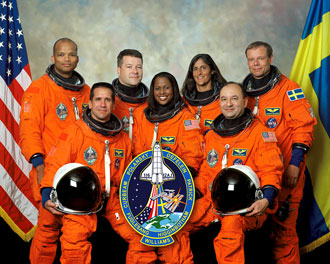
| |
La fotografia ufficiale dell'equipaggio
L'equipaggio della missione STS-116 che volerà sullo Space Shuttle Discovery è quì ripreso nella fotografia ufficiale.
Da sinistra vedete gli astronauti William Oefelein (pilota), Joan Higginbotham (Specialista di Missione) e Mark
Polansky (comandante della missione). Dietro potete vedere Robert Curbeam (Specialista di Missione), Nicholas Patrick
(specialista di missione), Sunita Williams (ingegnere di volo) e Christer Fuglesang (specialista di missione).
La missione prevede l'attracco dello space shuttle alla Stazione
Spaziale Internazionale (ISS), con l'installazione del modulo P5 Truss e dello Spacehab.
Nel ritorno sarà presente anche Thomas Reiter (ingegnere di volo) dell'Agenzia Spaziale Europea (ESA), il quale rientra a terra
dopo la permanenza nelle Expedition 13 (nell'ultima parte) e Expedition 14 (nella parte iniziale).
Cliccando l'immagine l'aprirete a 330 x 264 pixel.
Image credit: NASA
|
Di seguito riporto le schede biografiche dei sette membri dell'equipaggio, tratte dall'apposita pagina del sito internet della NASA.
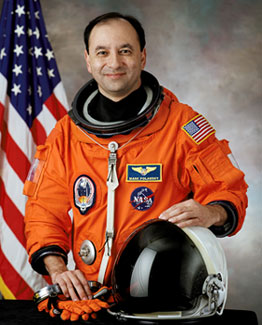
| |
Comandante Mark Polansky
Pilota collaudatore dell'Aeronautica statunitense, Mark Polansky è il comandante dello spce shuttle STS-116, il quale effettuerà
la ventesima missione all'International Space Station (ISS).
A former Air Force test pilot, Mark Polansky will lead the crew of STS-116 on the 20th shuttle mission to the space station.
Biografia;
intervista
Image credit: NASA |
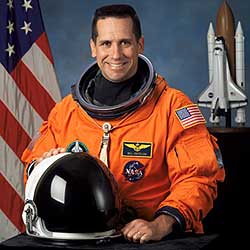
| |
Pilota William Oefelein
William Oefelein, che ha fatto più di tremila ore di volo con oltre 50 aeroplani, sarà il pilota dello space shuttle nella sua
prima missione nello spazio.
William Oefelein, who has logged over 3,000 hours flying more than 50 aircraft, will make his first journey into space as the
pilot for the STS-116 mission.
Biografia;
intervista
Image credit: NASA
|
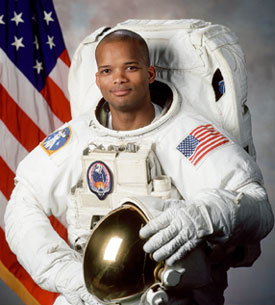
| |
Specialista di Missione Robert Curbeam
Veterano dello spazio con due voli sullo space shuttle, Robert Curbeam guiderà le tre passeggiate spaziali (EVA) assegnatigli
in qualità di specialista di missione per l'STS-116.
A veteran of two space shuttle flights, Robert Curbeam conducted three spacewalks before being assigned as mission specialist
for STS-116.
Biografia;
intervista
Image credit: NASA
|
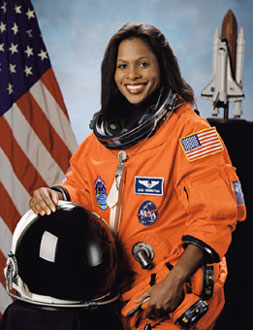
| |
Specialista di Missione Joan Higginbotham
Per aiutare nella costruzione dell'International Space Station (ISS),
Joan Higgibotham come primo incarico sull'STS-116 opererà col braccio robotizzato della ISS.
To assist with the construction of the space station, Higginbotham's primary task on STS-116 will be to operate the station's
robotic arm.
Biografia;
intervista
Image credit: NASA
|
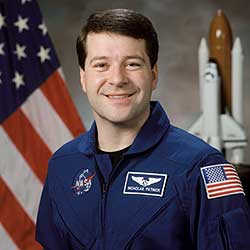
| |
Specialista di Missione Nicholas Patrick
Formatosi come istruttore di volo e astronauta dal 1998, Nicholas Patrick è assegnato alla STS-116 in qualità di specialista
di missione.
A member of the 1998 astronaut class and former flight instructor, Nicholas Patrick is assigned to STS-116 as a mission specialist.
Biografia;
intervista
Image credit: NASA
|
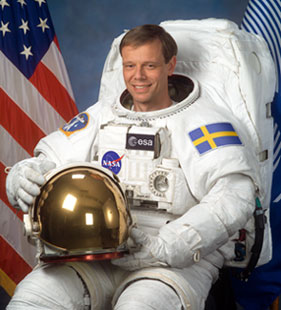
| |
Specialista di Missione Christer Fuglesang
Al suo primo volo nello spazio, l'astronauta dell'Agenzia Spaziale Europea (ESA) Christer Fuglesang fa parte del personale
della STS-116 in qualità di specialista di missione. E' di nazionalità svedese.
On his first spaceflight, European Space Agency astronaut Christer Fuglesang joins the crew of STS-116 as a mission specialist.
Biografia;
intervista
Image credit: NASA
|
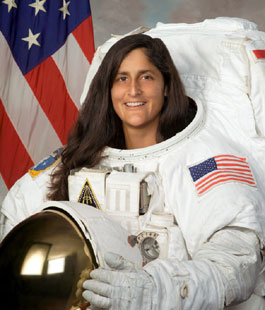
| |
Ingegnere di volo Sunita Williams
Sunita Williams fa parte dell'Expedition 14 attualmente in corso (NdR: della ISS, sostituendo Thomas Reiter), dove
prenderà servizio in qualità d'ingegnere di volo dopo il volo dello space shuttle STS-116 verso la International Space Station (ISS).
Williams will join Expedition 14 in progress and serve as a flight engineer after traveling to the station on space shuttle
mission STS-116.
Biografia;
intervista
Image credit: NASA
|
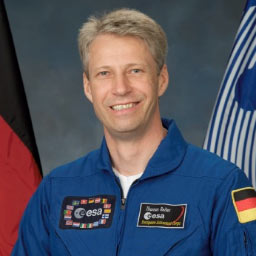
| |
Ingegnere di volo Thomas Reiter (ESA)
Thomas Reiter, astronauta dell'Agenzia Spaziale Europea (ESA) e ingegnere di volo dell'Expedition 14 a bordo dell'
International Space Station (ISS), ritornerà a terra con i membri
dell'STS-116 in quanto ha concluso il suo turno nello spazio.
Reiter, a European Space Agency astronaut and flight engineer for Expedition 14 aboard the International Space Station,
will return to Earth with the STS-116 crew.
Biografia;
intervista
Image credit: NASA
|

Il profilo della missione viene illustrato nel file
STS-116_Press_Kit.pdf (pdf; 6,7 MB; cortesia NASA)
Per approfondire l'argomento consiglio di visitare i seguenti siti:
STS 116 - la missione
Space Shuttle: Before the Countdown
Space Shuttle system
Le missioni al Kennedy Space Center
News from Kennedy Space Center
http://www.nasa.gov
NASA Television
Archivi: le missioni dal 1999 al 2004
Torna a inizio pagina
Articoli |
Fotografia, ccd e ricerca |
Dizionario |
Notiziari
Homepage
Copyright © 2006 di Lucio Furlanetto
Immagini copyright copy; 2006 di NASA/NASA TV

Pagina caricata in rete 8 dicembre 2006; ultimo aggiornamento (7°): 30 dicembre 2006
|



